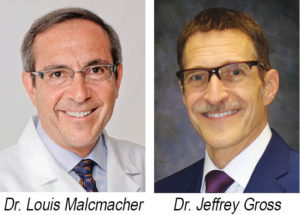 by Jeffrey Gross, DDS, FAGD of The Healthy Smile
by Jeffrey Gross, DDS, FAGD of The Healthy Smile
I met this patient and listened carefully to her problem and concern. She told me that she has two new partial dentures and struggles with both of them. Her difficulties were not the same for each of these new devices. Before we get to her problem, let’s take a moment to review and explain the subject of today’s discussion. Whenever someone loses teeth in their mouth, dentistry recommends replacing the missing tooth or teeth for whatever reason. When concerned about a single tooth replacement, we discuss implants and bridges as quick and easy solutions. If the patient is missing many teeth, permanent options due to complexity may be out of the question. Dentists look at removable options for replacing teeth, and we call these tooth replacements removable bridges or partial dentures. Both terms refer to the same type of apparatus. Teeth will sit on the gum tissue and anchor into place by attaching to the remaining teeth.
The teeth take up room in the mouth, which can sometimes be difficult to find. As we age, the space between the top and bottom teeth decreases. The natural wearing of the teeth through normal or abnormal use is common. The loss of space accelerates if we lose back teeth early in our lives. Since we don’t have back teeth with which to chew, the brunt of the chewing occurs on the front teeth. I have written extensively on why this phenomenon is not good or healthy. I want to add to the problems when we rely on our front teeth as the primary means of chewing. The extensive pressure on the front teeth causes those teeth to flare forward. As they angle and flare outward, the loss of space between the top and bottom teeth in the back of the mouth decreases considerably.
 With this loss of up and down space for teeth, replacement of teeth can become impossible. A partial denture is made up of a base composed of either metal or another material and then the artificial teeth themselves. All of this occupies space, and if there is a loss of vertical space, the partial denture will not work. What I have just described happened to my patient. She had so little space that the partials would not let her chew as her natural teeth would not touch each other.
With this loss of up and down space for teeth, replacement of teeth can become impossible. A partial denture is made up of a base composed of either metal or another material and then the artificial teeth themselves. All of this occupies space, and if there is a loss of vertical space, the partial denture will not work. What I have just described happened to my patient. She had so little space that the partials would not let her chew as her natural teeth would not touch each other.
The way to fix this problem and regain space is to make existing teeth, her natural teeth, taller. When teeth are big and not worn away, they create more space in the areas of missing teeth. Making teeth larger is not a difficult job. Through the use of bonding and sometimes crowns, I can make teeth taller, resulting in the ability to replace missing teeth with a well-made partial denture.
Let’s get back to our patient. She complained that her lower partial was hurting her teeth because it was too tight. I was able to fix that easily with some minor adjustments. Her other complaint of not being able to chew was a result of our lack of space, as I just described. Her lack of space was so bad that, in addition to complaining about not being able to chew, she showed me a broken front tooth. The tooth fracture occurred because of the tremendous amount of chewing force that was put on that tooth due to the loss of her back teeth.
I proposed that we remove the fractured tooth, build up her remaining five teeth and then make a new partial. The treatment plan was simple once we determined the source of her problem. If you find that chewing has become a chore or causes you discomfort, please call me at 440.892.1810 and set up a visit. I look forward to hearing from you.
Jeffrey Gross, DDS, FAGD is an Ohio licensed general dentist and is on the staff of Case Western Reserve School of Dental Medicine.
The Healthy Smile • 27239 Wolf Road, Bay Village, OH 44140 • 440-892-1810 • www.jeffreygrossdds.com
 The Villager Newspaper Online Your Community News – Cleveland's Westshore
The Villager Newspaper Online Your Community News – Cleveland's Westshore






